- Home
- InDesign
- Discussions
- How can I add a .5 gap in between two facing pages...
- How can I add a .5 gap in between two facing pages...
How can I add a .5 gap in between two facing pages?
Copy link to clipboard
Copied
i need to create a gap for a book cover, but the gap I've created only lets me go to 1in and nothing smaller. How can I create a .5in gap as the spine of my book?
Copy link to clipboard
Copied
You can't do it with Facing Pages. It's best to make the cover—back cover, spine and front cover—a new document. You should use the Page tool (third tool from the top of tools) to change the size of the spine to the actual spine width. That will give you the most flexibility.
1. When you create the new document, make the page size the size of the cover (e.g., 6 x 9 inches), but create three pages. FACING PAGES MUST BE TURNED OFF.

2. InDesign tries to create pairs of pages (it calls it shuffling). You want to UNCHECK both shuffling options on the Pages panel menu:
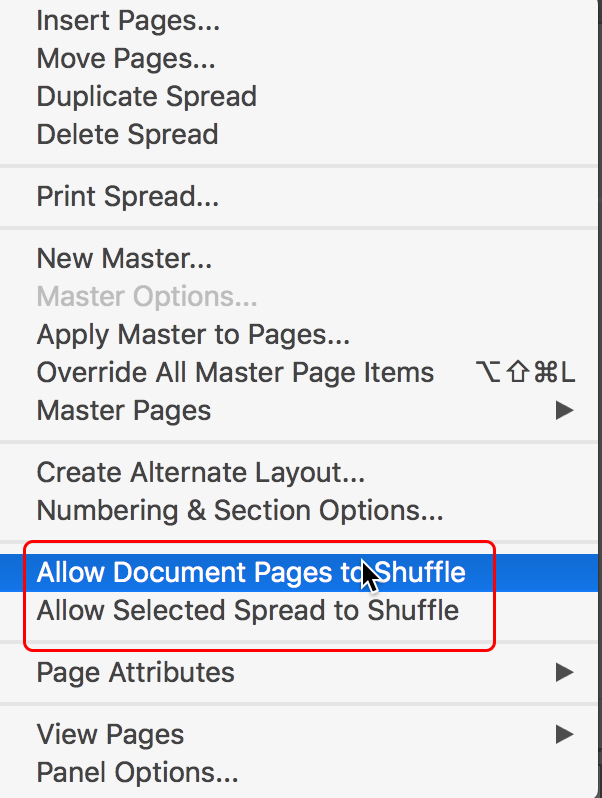
3. To create a multi-page spread, you want to drag page 2 beside 1; then drag page 3 beside 2. You want to look for the ] (bracket) icon to create a spread:

When finished looks like this:
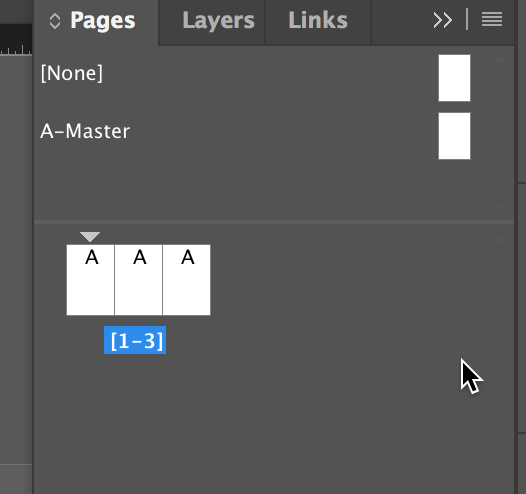
4. Use the Page tool to select page 2 (the spine) and change its width to the spine width in the Control panel (e.g., .5 in). Then move it beside page 2 (make sure Reference Point at left end of Control panel at upper left point):
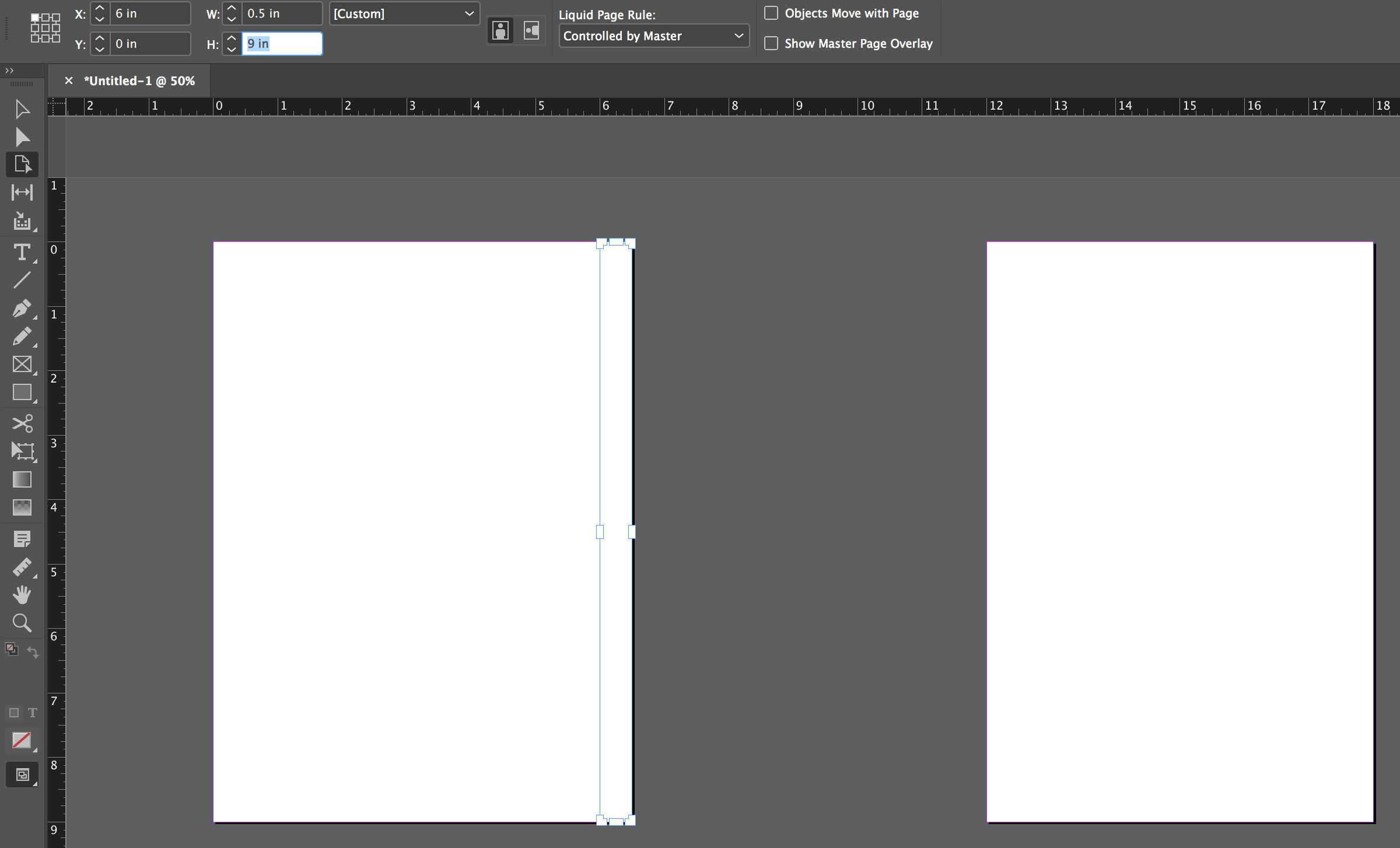
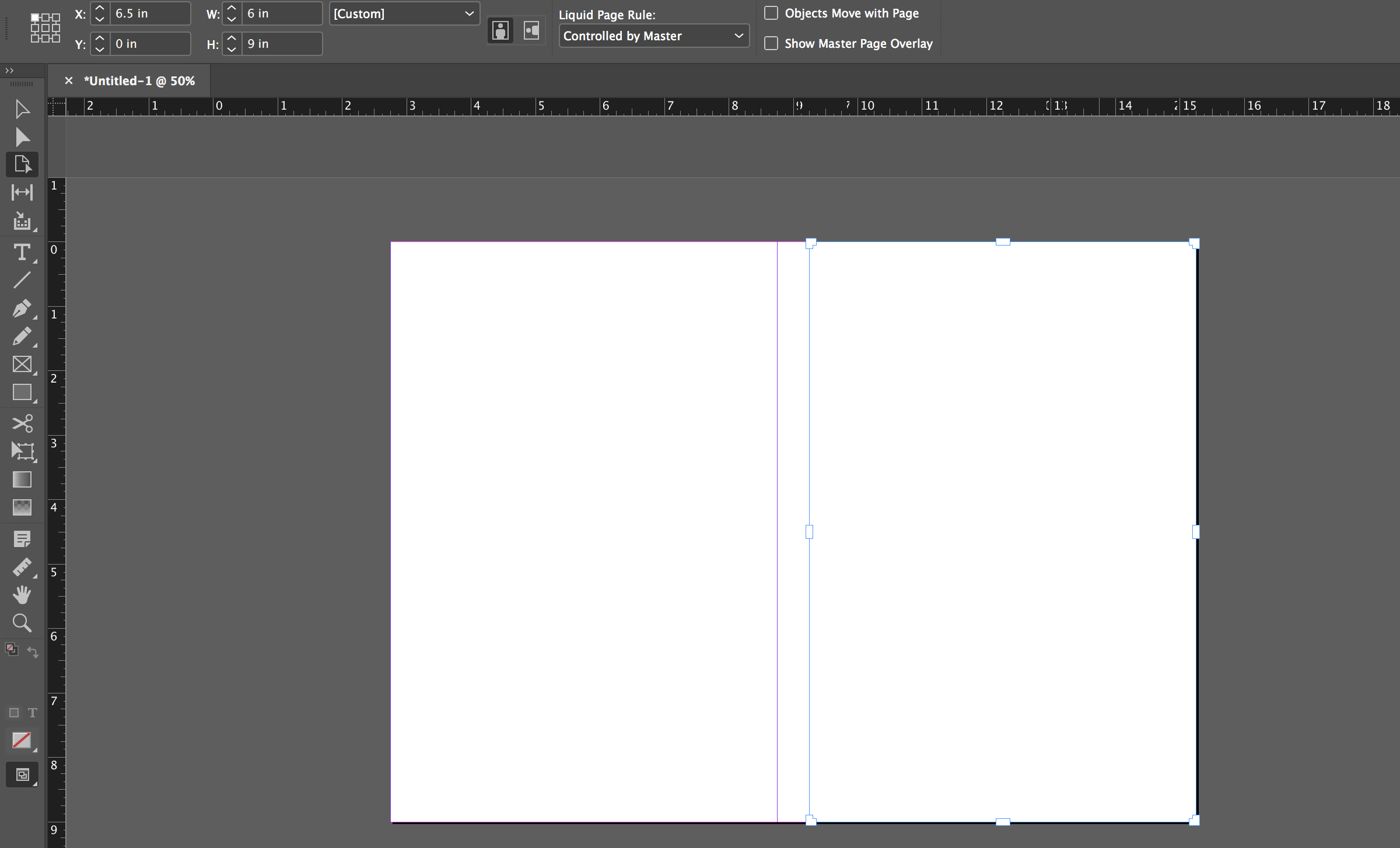
Good luck. I teach this method to my InDesign class at the Graphic Design program at Berkeley Extension.
Copy link to clipboard
Copied
https://forums.adobe.com/people/Steve+Werner wrote
You can't do it with Facing Pages.
Hi Steve,
hm. Why a gap at all? I ask myself.
To be flexible if the spine changes its width?
In this case one would be better off doing it with a facing pages document.
Only in a facing pages document the pages next to the spine would move automatically, if you change the width of the spine. Or if you change the width of the cover or the back.
Regards,
Uwe
Copy link to clipboard
Copied
In this case one would be better off doing it with a facing pages document.
Yes, I think that is right. If the pages are not facing then I think you would always have to realign the front and back pages with the spine pages—it wouldn't happen automatically. For my clients the cover design always happens after the interior, so I've never considered 3 pages.
Copy link to clipboard
Copied
I can't think of any reason why you have to set up the cover mechanical as multiple pages. I've produced hundreds of book covers and the back + spine + front can be set up on a single page:
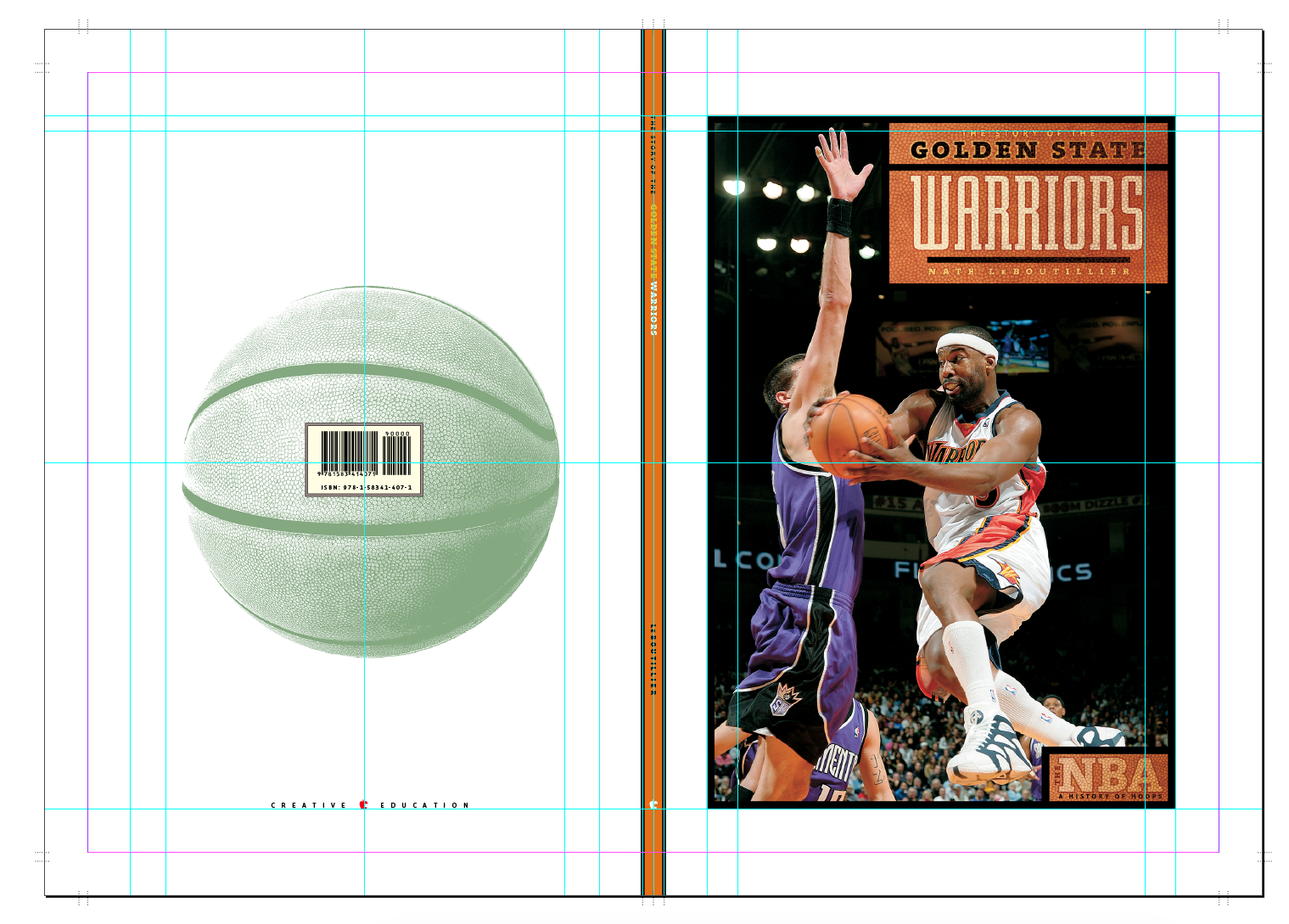
Copy link to clipboard
Copied
I would agree that this is in theory the best way to do this, possibly with a new master page with a custom page size. The real problem tends to be on “back end” where the prepress folks don't know how to handle a PDF file with multiple page types and sizes.
- Dov
PS: Look for better support for this type of workflow in the future with PDF/X-6 currently under development.
Copy link to clipboard
Copied
The real problem tends to be on “back end” where the prepress folks don't know how to handle a PDF file with multiple page types and sizes.
I guess you could export the 3 pages as a spread, but I'm not seeing why you would need multiple pages—there's no imposition happening.
Copy link to clipboard
Copied
https://forums.adobe.com/people/rob+day wrote
The real problem tends to be on “back end” where the prepress folks don't know how to handle a PDF file with multiple page types and sizes.
I guess you could export the 3 pages as a spread, but I'm not seeing why you would need multiple pages—there's no imposition happening.
I should have been more explicit. I was looking at the use case where you used a single InDesign document and subsequent PDF file to contain not only the cover, but the text pages and everything else in the final “product.”
- Dov
Copy link to clipboard
Copied
Dov, I’m curious. How would PDF/X-6 handle that use case?
Copy link to clipboard
Copied
https://forums.adobe.com/people/Steve+Werner wrote
Dov, I’m curious. How would PDF/X-6 handle that use case?
Wouldn't you really like to know? ![]()
PDF/X-6, currently under development by ISO TC 130, WG2/TF3 (of which I am chair), is based on the PDF 2.0 specification released last year.
There are two features of PDF 2.0 that are relevant here:
(1) Output Intents may now be specified at the page level, overriding a document level output intent. As such, you could have a PDF/X-6 file in which different pages have different color characteristics (such as a cover printed on thick, glossy stock and text pages printed on thin text stock).
(2) DPart (Document Part) data, a feature of PDF/VT-1, now an optional feature of PDF 2.0, allows specification of production data for individual pages and/or ranges of pages, allowing smart production systems to choose substrate, handling of such (duplex, folding, etc.), and other production aspects in a device-independent fashion.
Taking these two features together, you could imagine a single PDF file with pages representing covers, text pages, glossy illustration pages (some of which might be fold-ins), and even a dust cover with multiple color characteristics (provided by separate output intent profiles on particular pages) possibly printed on multiple devices.
NOW, imagine that the multipage InDesign document allows specification of default color spaces and production data at the master page level and that this yields the proper PDF/X-6 output … You would no longer need separate InDesign documents and PDF files for the multiple components of a printed “product.”
Disclaimer: I have not (yet) made a product feature announcement or commitment! ![]()
Oh, and by the way, PDF/X-6 finally allows for annotations, including contents of forms fields, within the file!
Does this answer your question?
- Dov
Copy link to clipboard
Copied
It sure does answer my question. But it sounds like it will take a while to implement, given how fast (;-) ) your standards organizations work, and then Adobe to implement, and then people to use it.
Not holding my breath.
Copy link to clipboard
Copied
Actually, we expect PDF/X-6 to become final and published by the end of 2019; we already have a pretty solid draft.
Implementation is as you note, another issue, although we know RIPs will be available for it sooner than you might think and internal discussions within Adobe are already in progress with regards to the applications.
But like PDF/X-4, it will take a while to propagate. The good news is that the advancements of PDF/X-6 over PDF/X-4 aren't of the magnitude of PDF/X-4 over PDF/X-1a. PDF/X-4 will be perfectly adequate for many if not most current printing scenarios, including those using live transparency and ICC color management.
- Dov
Copy link to clipboard
Copied
Yeah, I'm curious too. I like more efficient work-flows.
Thing is, most often my covers are not printed on the same press and sometimes not by the the same print establishment.
Copy link to clipboard
Copied
Anyhow you look at it, covers differ in paper type from the content. So yes, I design covers separately, using Steve Werner‘s method since I can use different page sizes in a document. And as I also need a PDF version of my books (mostly annual reports), I place the front and back from the initial book design into a new document and just add the spine.
I suppose Steve’s and rob day‘s methods are equivalent, at at the end of the day it’s just a question of personal preference.
Copy link to clipboard
Copied
I was also going to add that it's probably a good idea to check to see if the printer has a preference. But if each method produces a spread for the cover correctly, each method should work.
Copy link to clipboard
Copied
Yes, I know how to both use different page sizes, export as spreads for obtaining a single page PDF, as well as the single page method Rob showed. I've done both methods for a long time. In separate files.
I have recently ran into one service provider that hates the trim marks on the spine for the 3+ page method. I think I know why, but I cannot get a clear answer from him.
I'm just curious about how PDF/X-6 resolves anything having to do with disparate page sizes in a single PDF is all.
Mike
Copy link to clipboard
Copied
It's important to teach designers to check with their service provider about the method THEY prefer.
However, if the method of the service provider is too outdated or onerous (e.g., outline all the fonts, or the designer is supposed to do the imposition) then it's time to look for a new one (if you're able).
Copy link to clipboard
Copied
Yes, it is important to check with the provider—assuming one knows. In this case I learned about the issue from the company I created the cover for who had chosen this provider for a reprint. I just loaded the PDF back into ID and created a new one. Problem solved.
I don't normally care about the whole outlined fonts thing. I just use Acrobat or pdfToolbox and do it. That whole issue isn't worth the time of day. While I can recommend print providers or tell a company to avoid such practices, it's their call as you say.
Mike
Copy link to clipboard
Copied
As long as my print service provider is happy with the files I send, I’m happy.
Let’s see about PDF X/6 when it’s ready.
Steve and Bob gave good advice. Both answers are correct.
Copy link to clipboard
Copied
You are correct in that some automated prepress processes do not like PDFs with multiple page sizes, however I have never met a prepress professional who does not know how to extract pages from a PDF.
In my experience, most covers are supplied separately (either as PDFs or native files).
Inside covers are rarely properly spread back for the hinge glue area and bleed, not to mention the occasional inside cover cross page line-up. A typical perfect bound hinge is .25" where there should be no ink, except for a small bleed area. this also applies to the left side of the first text page and the right side of the last text page.
Good communication with your printer is always a good idea.
Copy link to clipboard
Copied
You have the flexibility of easily changing the spine width if number of pages or paper weight changed. Of course, you would export as spreads. Result: One PDF.
Find more inspiration, events, and resources on the new Adobe Community
Explore Now

